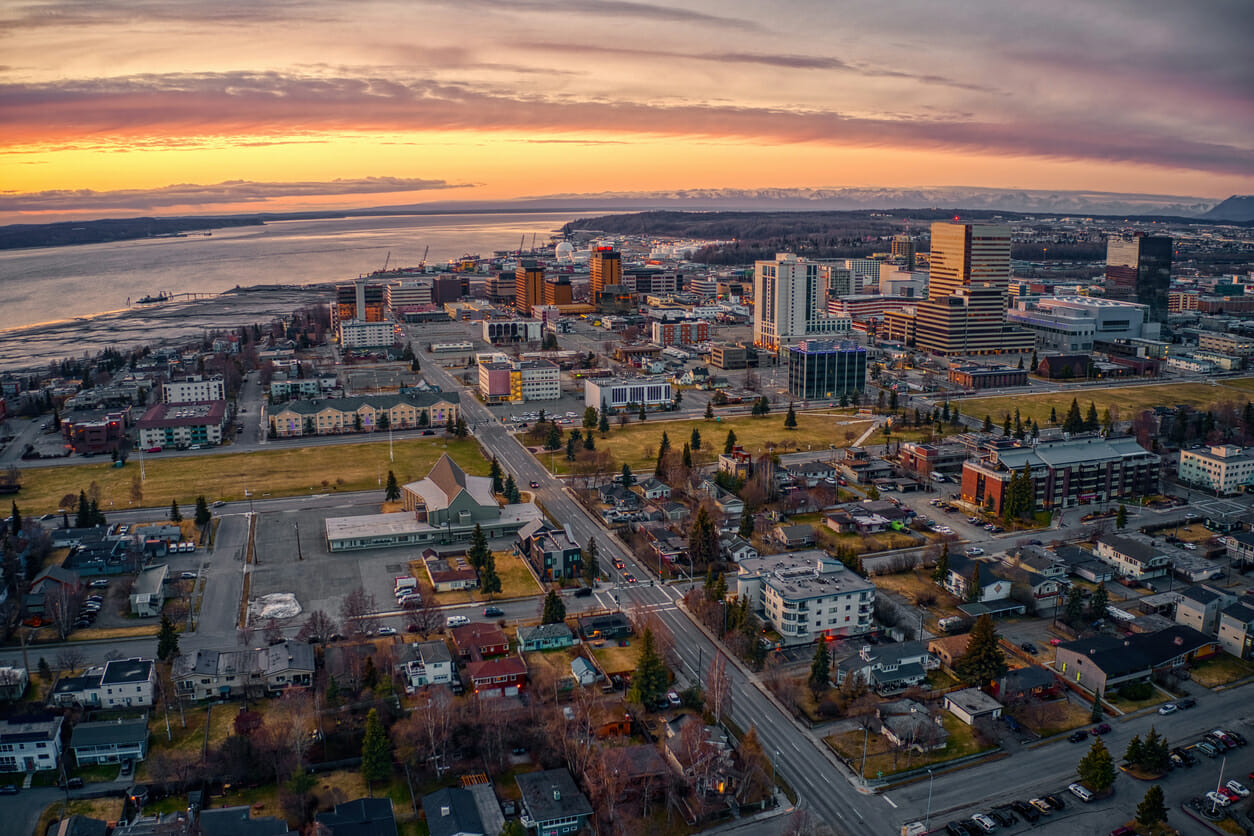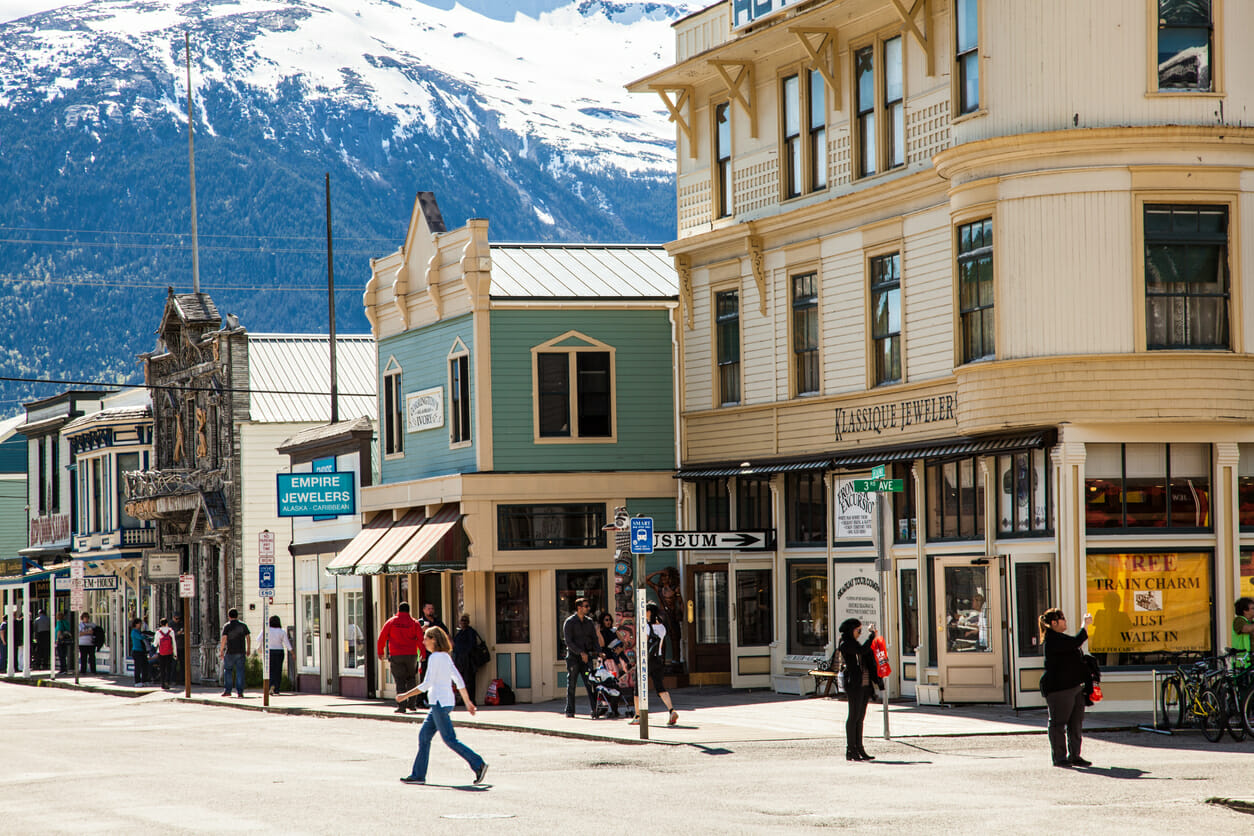
Criminal Justice in Alaska
Despite its rural nature and geographically isolated location, statistical data surrounding Alaska’s criminal justice system is well documented. The following sections briefly outline key data about Alaska crime, incarceration, and criminal justice, while also noting areas that have been successful and areas that could use improvement.
Criminal Justice Statistics in Alaska
Alaska is the fourth-least populated state in the United States. It has the 39th highest incarceration rate, after Connecticut but before North Dakota. While Alaska’s jail population is relatively low, the state’s prison population is comparatively high, considering the state’s sparse overall population. With 1,782 inmates in state prisons (and 90 individuals in jail at any given time), Alaska incarcerates 244 inmates for every 100,000 people in the state.1

According to a 2019 report on Alaska criminal justice published in the National Institute of Corrections, Alaska melded its jails and prisons into a Unified System. Alaska is just one of six states with such a system.2 Under that system, Alaska manages 12 prison facilities and 15 locally operated jails.3 The Spring Creek Correctional Center in Seward houses some 500 prisoners and is the only maximum-security prison in the state. The Goose Creek Correctional Center in the Matanuska-Susitna Borough is the largest prison in Alaska, with some 1,000 prisoners. There are no federal prisons located in Alaska.
Alaska Crime and Recidivism
Alaska’s 2019-reported incarceration rate of 244 per 100,00 population is notably lower than the 2017 report of 486 incarcerated for every 100,000 population. However, the violent crime rate has risen, from 829 incidences per 100,000 in 2017 to 867 per 100,000 in 2019.
While a recent drop in the prison population is a good sign, there is controversy over Alaska outsourcing much of its prison population to private prisons in other states (hence the 2017 to 2019 drop in the incarceration rate). This practice has been heatedly debated as recently as the Alaska State Legislature’s 2020 House State Affairs Committee.4 While Alaska residents have repeatedly voted against private prisons in their state, the practice of outsourcing Alaskan offenders to prisons in other states continues. This practice is controversial, as it inhibits Alaskan residents from easily (and affordably) visiting their incarcerated family members.5
Part of the reason why Alaskan lawmakers felt compelled to outsource prisoners to other states was that the population of incarcerated individuals rose significantly between 2005 and 2014. During that period, the number of incarcerated spiked by 27%, rising three times faster than the growth of the state’s population over that same period. State officials predicted that, if it continued, the growth rate would cost the state an additional $169 million over the coming ten years, hence the quick-fix approach to outsource prisoners to prisons in other states.

But why the spike in incarceration? In addition to new inmates entering the prison system, Alaska’s rising recidivism rate is a key factor that led to the spike in the prison population. According to the data, 65% of Alaskan prisoners are incarcerated for a felony. In 2006, 70% of felony offenders returned to incarceration at some point after their release from prison. By 2016, that percentage had slowly fallen to 60%, but 60% is still a concerningly high recidivism rate and is directly connected to Alaska’s prisoner population spike. That recidivism rate means, in addition to new prisoners entering the system every year, the Alaskan criminal justice system is not working for more than half of the felony offenders already in the system, resulting in more individuals returning to prison shortly after their release.
It’s not enough for Alaskan residents to reject private prisons at the ballot box. Alaskans must also demand more effective criminal rehabilitation programs to reduce recidivism and fully rehabilitate inmates. If this does not occur, Alaska’s correctional programs will remain overburdened, and the state will have to continue outsourcing to contend with the growing prison population (or build new prisons in the state, also unpopular with voters).
Alaska Criminal Rehabilitation
Thankfully, there are some criminal rehabilitation programs conducting reform services in Alaska. For example, ten drug court programs in the state seek to help Alaskans convicted for personal-use-possession of mind-altering substances.6
In 2014, former Governor Sean Parnell famously signed legislation that expanded the treatment services and rehabilitation modalities utilized in Alaskan prisons, in order to combat recidivism.7 And in 2016, former Governor Bill Walker oversaw a measure that prioritized prison space for violent offenders, expanded discretionary parole capacity, and strengthened probation and parole supervision, also to reduce recidivism.8
Unfortunately, some of Alaska’s more successful criminal reform programs have ended, such as the Akeela nonprofit organization that worked with incarcerated Alaskans on substance abuse issues.9
It would seem that current conditions; high recidivism, a withdrawal of criminal rehabilitation programs, a spike in prisoner outsourcing, and a reduction in resources for effective reform will likely escalate already existing problems in Alaska’s criminal justice system.
Alaska’s Need for Alternatives to Incarceration
Alaskan lawmakers, concerned families, criminal justice experts, and human rights organizations have worked extensively to implement rehabilitation programs inside Alaska prisons and improve criminal reform efforts. Some education programs inside prisons in Alaska have also been tried.
Over the decades, some of these alternatives to incarceration have been attempted (or are currently in place) in the state:
- Drug court
- Supervised probation
- House arrest for nonviolent, low-level offenders
- Rehabilitation for inmates convicted of drug possession
- Separation of violent offenders from nonviolent offenders
While such alternatives to prison come with good intentions, they have not been implemented broadly enough to curb the stark 60% recidivism rate for Alaskan felony offenders. But as mentioned earlier, rather than expanding evidence-based alternatives to incarceration (that may have reduced recidivism), Alaskan lawmakers instead sought to mollify the public’s objection to more prisons by simply outsourcing some inmates. They also dramatically reduced prison sentences for other inmates, but without first effectively rehabilitating those inmates, hence the rising recidivism.
The Alaska Department of Corrections is the state’s 7th costliest budget item. Outsourcing prisoners to private prisons is still costly to taxpayers, as would be the building of new prisons and facilities in Alaska. However, dramatically reducing prison sentences before prisoners have a chance to rehabilitate is also not a solution.10

Criminal Rehabilitation in Alaska Can Be Done
No prison system is perfect, and although Alaska has made some positive moves in addressing crime, incarceration, criminal justice, and public safety, the problems persist. Unfortunately, one of Alaska’s more recent budget proposals still supports the prisoner outsourcing plan, even though such a plan is clearly only a band-aid approach. Quoting that budget proposal, “It costs approximately $150 per day to house a criminal in Alaska, compared to just $95 per day in the Lower 48.”11
“It costs approximately $150 per day to house a criminal in Alaska, compared to just $95 per day in the Lower 48.”
But Alaskans know that outsourcing prisoners is not the answer, even if it is cheaper than keeping prisoners in-state. Residents have already seen the benefit of utilizing alternatives to incarceration, and such options should be expanded and encouraged across all sectors of the state’s correctional system. By utilizing programs like King County’s LEAD initiative and by expanding educational programs for inmates, Alaska can implement successful alternatives to make a permanent, positive impact for the incarcerated.12
Sources:
- Alaska Judicial Council. “Alaska Criminal Justice Commission 2020 Annual Report.” Alaska Judicial Council, 2020. ajc.state.ak.us
- NIC. “Alaska 2019.” National Institute of Corrections, 2019. nicic.gov
- ADOC. “Alaska Department of Corrections.” ADOC, 2022. doc.alaska.gov
- Juneau Empire. “Many Alaska prison inmates still being sent thousands of miles away.” Juneau Empire, 2005. web.archive.org
- Alaska State Legislature. “House State Affairs Committee Meeting.” Alaska State Legislature, 2020. akleg.gov
- BJA. “State Criminal Justice Profile.” Bureau of Justice Assistance, 2014. bjafactsheets.iir.com
- The University of Alaska. “Senate Bill 64 – Omnibus Crime Bill.” University of Alaska Anchorage, 2014. scholarworks.alaska.edu
- Alaska State Legislature. “Omnibus Crime Law & Procedure; Corrections.” Alaska State Legislature, 2016. akleg.org
- Alaska Public Media. “Why prison drug treatment programs in Alaska ramped down at ‘exactly the wrong time.’” Alaska Public Media, 2017. alaskapublic.org
- Urban Institute. “Project Alaska.” Urban Institute, 2022. urban.org
- Office of Governor Michael J. Dunleavy. “An Honest Budget, Fiscal Year 2020.” Governor’s Office, 2020. gov.alaska.gov
- leadkingcounty.org

